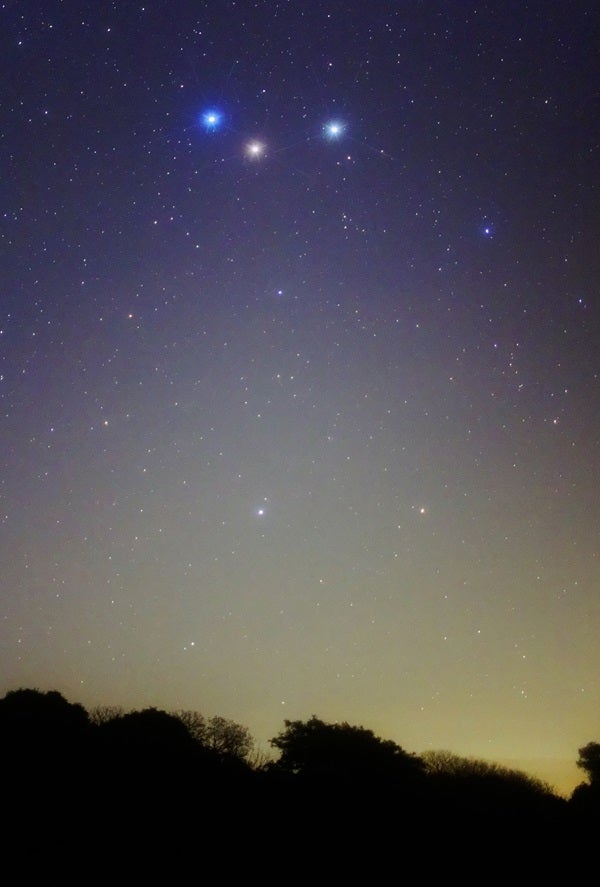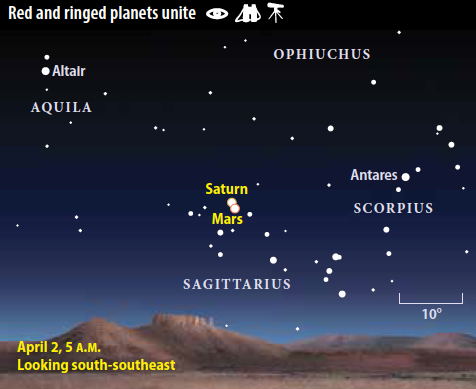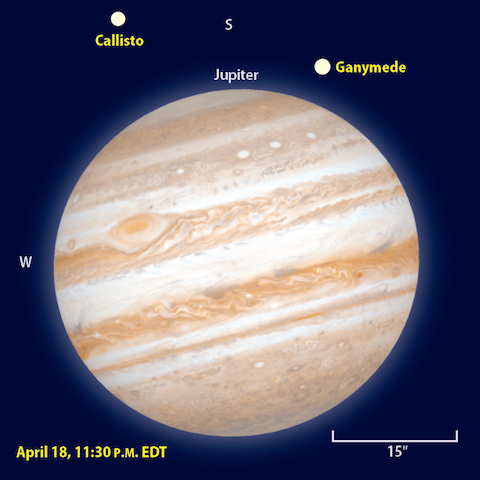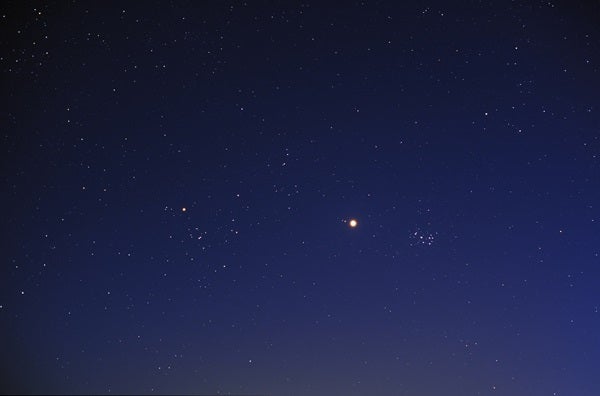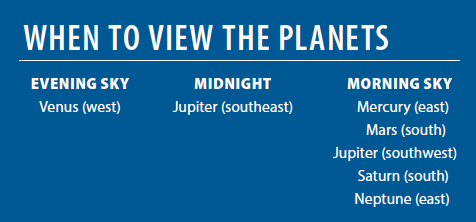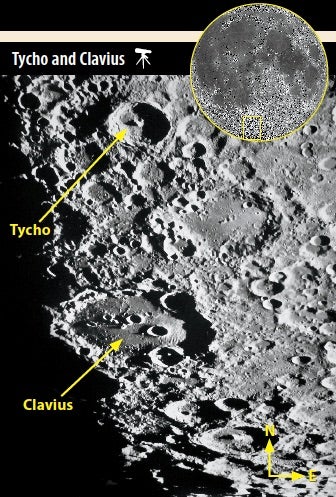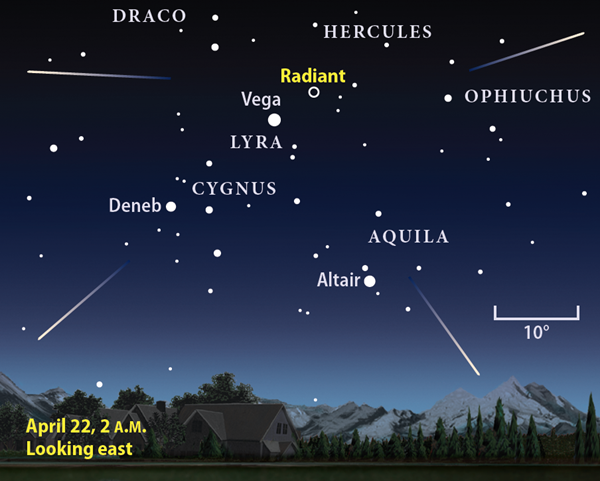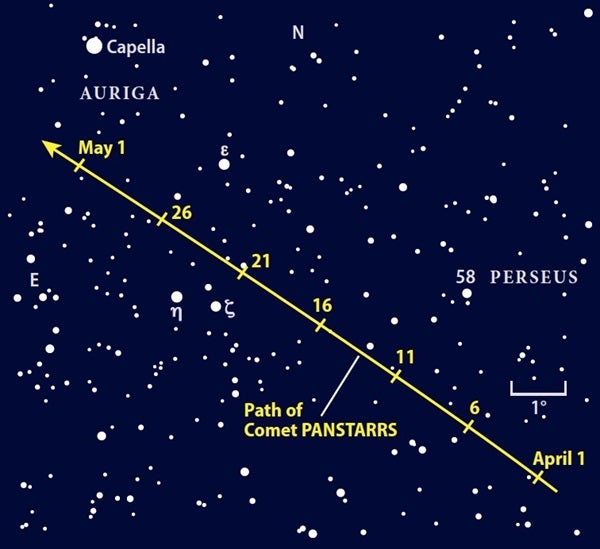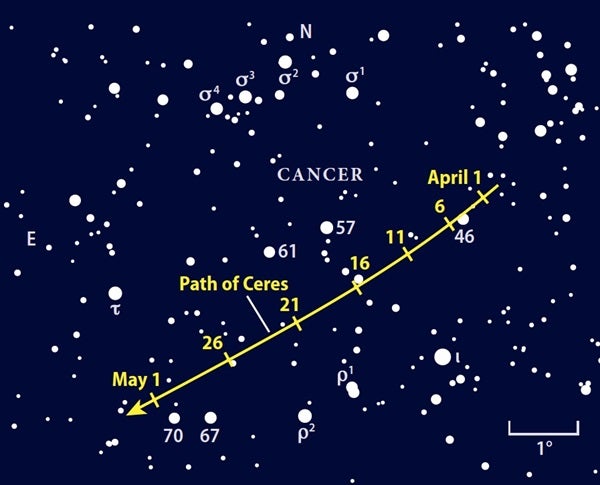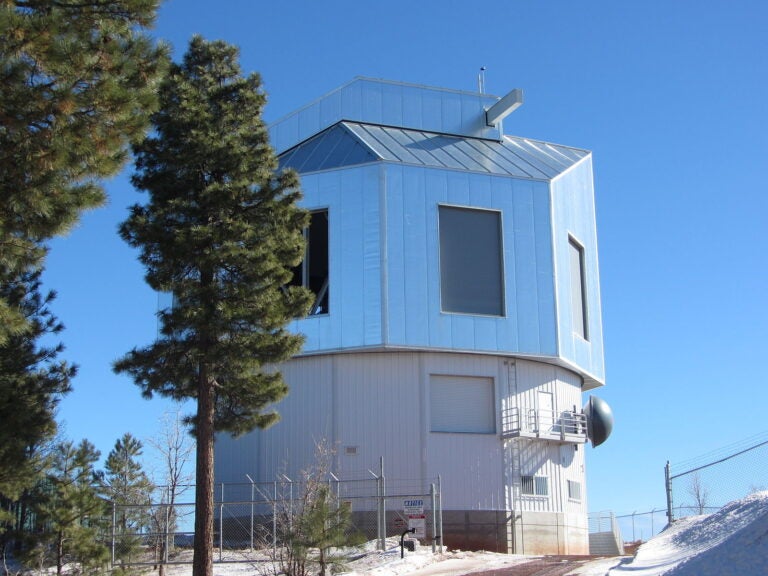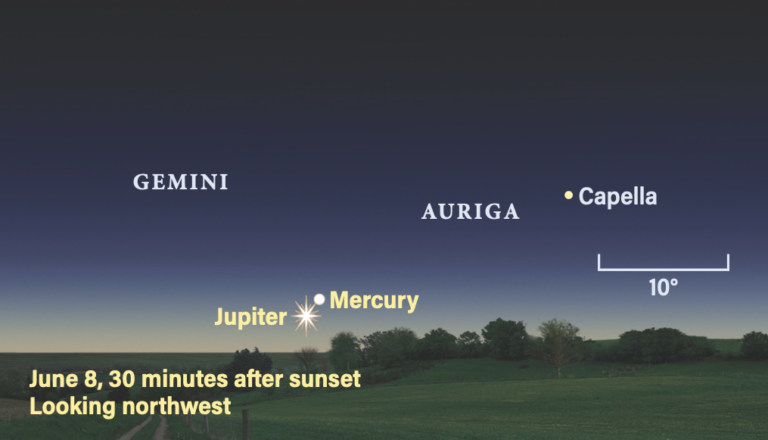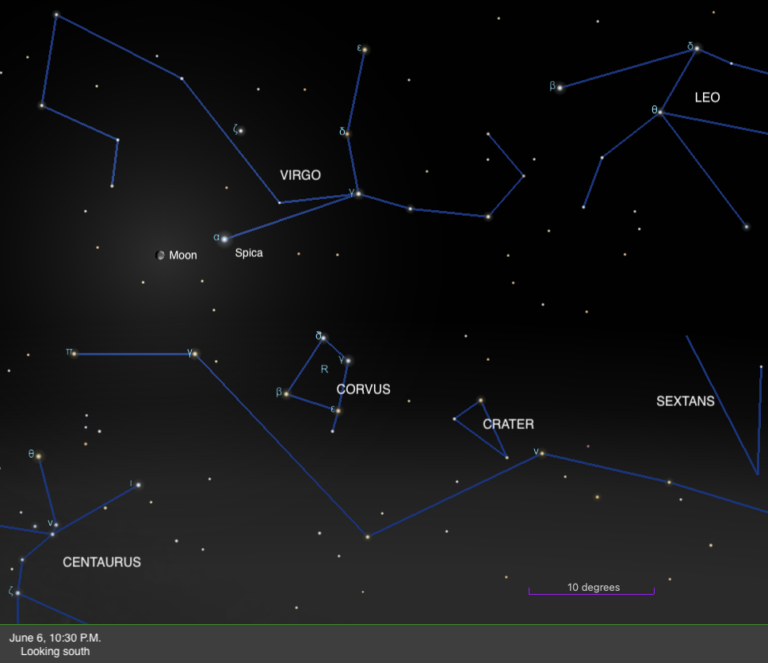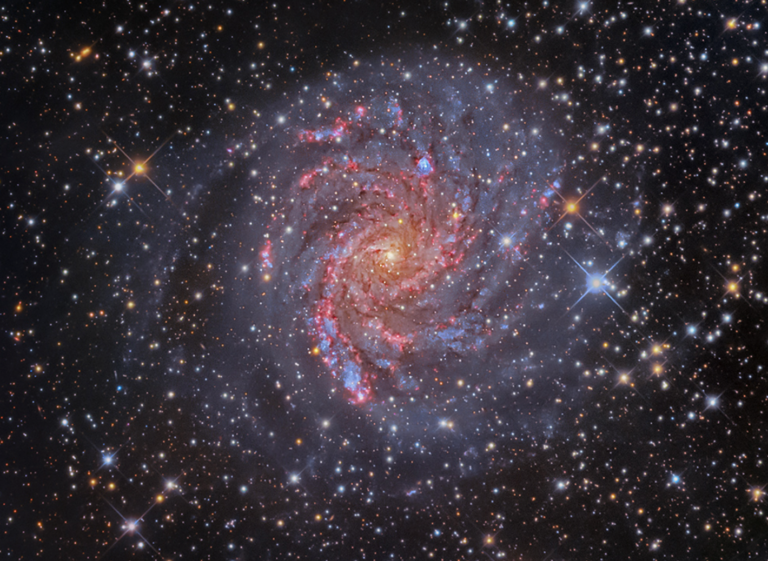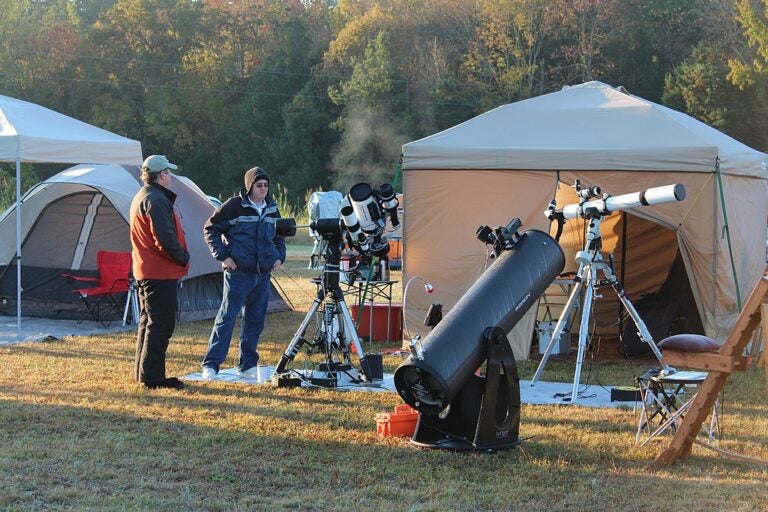The first object you’ll see after the Sun sets is Venus. The dazzling planet shines at magnitude –3.9 from its perch low in the western twilight sky. On April 1, it stands 10° above the horizon 45 minutes after sundown. You’ll have less than an hour to target Venus through a telescope, and even then the view leaves much to be desired. The inner world shows a bland disk that appears 10.6″ across and 94 percent lit.
A crescent Moon joins Venus shortly after midmonth. If you have clear skies April 17, be sure to look for the 2-day-old Moon 5° to the planet’s left. As the sky darkens, the Pleiades star cluster (M45) slowly emerges 9° directly above Venus. Set against a deepening twilit sky, the fine grouping offers a great photo opportunity. The Moon and Venus both dip below the horizon around 9:30 p.m. local daylight time.
The planet moves eastward relative to the background stars during April, passing from Aries into Taurus on the 19th. Venus slides 4° south of the Pleiades on the 23rd and ends the month a similar distance north of the V-shaped Hyades star cluster. A telescope reveals little change in the world’s appearance by April’s close, however. It then appears 11.5″ across and the Sun illuminates 89 percent of the disk.
Jupiter will reach opposition and peak visibility during May’s second week. Change happens slowly for a planet this far from the Sun, however, and its physical appearance remains nearly constant during April. Jupiter brightens almost imperceptibly, increasing from magnitude –2.4 to –2.5, and a telescope shows the disk swelling only from 43″ to 45″ across.
Your best views of Jupiter won’t come when it hangs low in the evening sky, but in the early morning hours when it climbs well above the horizon. From mid-northern latitudes in early April, the planet stands 30° or higher from about 2 to 5 a.m. local daylight time. (It reaches the same altitude two hours earlier by month’s end.)
Jupiter’s dynamic atmosphere ranks among the top sights in the solar system. Even beginners have no trouble spotting the planet’s two dark equatorial belts that straddle the equator. More subtle clouds, spots, and belts reside on the edges of these features as well as closer to the poles. All of them rotate with Jupiter’s 10-hour period, so they present a constantly changing scene.
Our view from Earth always shows the jovian equatorial regions best. But once every six years or so, we get a slightly enhanced view of one pole or the other as the planet’s axis tilts a bit in our direction. This tilt reaches a maximum in April, when the south pole tips 3.4° toward Earth and we get a better-than-normal look at Jupiter’s south polar region.
The modest tilt shows up more clearly in the behavior of the four bright Galilean moons. Because they lie in Jupiter’s equatorial plane, their orbital motions carry them farther north or south of the planet’s center than usual. The effect shows up most clearly with the two outer moons, Ganymede and Callisto.
But an even better example of the orbital tilt arrives the night of April 18/19. Both Ganymede and Callisto are then on the far side of Jupiter and appear south of the planet’s disk. Although Jupiter does pass in front of Ganymede early that evening, the moon returns to view by 11 p.m. EDT. Callisto lies well south of the planet all night and never enters the shadow.
As Jupiter climbs high in the south, Saturn and Mars appear in the southeast. The two rise together around 2:30 a.m. local daylight time April 1. Just 1.4° separate them that morning, and the gap closes to 1.3° at their conjunction on the 2nd. The colorful pair appears against the stunning backdrop of northern Sagittarius, with the 5th-magnitude globular star cluster M22 just 0.4° southwest of Mars. The Red Planet shines at magnitude 0.3, and yellowish Saturn glows 0.2 magnitude fainter.
Saturn remains almost stationary this month, never straying more than 2° from M22. But Mars, in its closer and faster orbit around the Sun, moves eastward at a comparatively rapid pace. By the time a waning gibbous Moon passes by the morning of the 7th, the planets appear nearly 3° apart. At the end of April, 14° separate the pair.
Although naked-eye and binocular views of Saturn are impressive, plan to spend time observing the planet through a telescope. In mid-April, the planet’s disk measures 17″ across the equator while the ring system spans 39″ and tips 25° to our line of sight. The large tilt assures nice views of ring structure.
While Saturn’s appearance changes slowly in April, Mars seems in a hurry to deliver on its finest apparition in 15 years. The Red Planet reaches magnitude –0.3 by the end of April, some 75 percent brighter than when the month began. During the same period, its diameter swells from 8.4″ to 11.0″, an increase of 30 percent. Still, this is but a prelude to what lies ahead. At its long-awaited peak in late July, Mars will shine 10 times brighter and more than double in size from its appearance in late April.
But this doesn’t mean you should skip viewing the planet in April. Now is the time to practice your observing skills and imaging techniques. A trained eye will see far more detail on the rocky world’s surface. Just be sure to view after the planet climbs high enough to be clear of the worst atmospheric turbulence near the horizon. From mid-northern latitudes, this means waiting until the hour before twilight begins.
If you observe Mars at the same time every morning — which is almost a necessity this month with the planet best positioned just before dawn — you’ll see only a slight change in what’s visible on successive nights. That’s because Mars rotates once every 24 hours, 37 minutes, so the longitude at the center of the martian disk shifts only about 10° every 24 hours. (The planet’s phase is the one constant; the disk remains 88 percent lit all month.)
Here’s a rundown on the main features visible along the planet’s central meridian at 5 a.m. EDT this month. The elongated neighbors Mare Cimmerium and Mare Sirenum take center stage during April’s first week. On April 11 and 12, look for the dark spot Solis Lacus. But April saves its finest features for month’s end: On the 29th and 30th, the planet’s most prominent dark area (Syrtis Major) and bright area (Hellas) both lie near the disk’s center.
Early risers can catch Neptune in binoculars during April’s final week. The magnitude 7.9 planet glows faintly and stands just 5° high in the east at dawn’s first light. If you’re up for a challenge, hunt for it between the 4th-magnitude stars Lambda (λ) and Phi (ϕ) Aquarii. Neptune lies 1.5° west-southwest of Phi on the 30th. If atmospheric conditions prevent you from seeing these stars, wait for better circumstances in May.
Mercury also makes a brief appearance before dawn in late April, but it won’t be much easier to see. The innermost planet reaches greatest elongation on the 29th, when it lies 27° west of the Sun but climbs only 4° above the eastern horizon 30 minutes before the Sun rises. Glowing at magnitude 0.4, it will be hard to pick out in bright twilight.
Uranus passes behind the Sun from our vantage point April 18 and remains hidden in our star’s glare all month. It will return to view before dawn in late May.
The craters Tycho and Clavius rank among the favorites of most Moon observers. The two lie in the Moon’s southern hemisphere and stand out in a magnificent play of light and shadow when the Sun rises over them April 24. Under this low Sun angle, Tycho’s normally brilliant ray system is largely hidden from view. But you still should be able to identify the crater from the signs of its youth: the prominent bowl, sharp rim, and well-defined central peak. A large majority of features in the crater-crowded southern highlands look nothing like it.
Clavius is the huge feature even closer to the southern limb. Its debris-filled floor and softer rim are telltale indicators of the relentless bombardment it has suffered over the past few billion years. Take a close look inside the shallow bowl to see a neat curving chain of more modest impact features. Over the course of an hour, track the shadows as they retreat and spy still-smaller craters.
As the Moon waxes toward Full on the 29th, Tycho’s rays become increasingly obvious. Also note the darker ring around its raised rim. Heat from the blast that created Tycho caused the surrounding surface to partially melt and lose its lighter shade. Although Clavius remains prominent at Full Moon because it is so big and distinct, many of the nearby smaller craters that were obvious on the 24th practically disappear under the higher Sun.
The first of spring’s major meteor showers peaks before dawn April 22. The Lyrids benefit this year from dark skies — the First Quarter Moon sets shortly before 2 a.m. local daylight time. That nicely coincides with when the radiant, the point in the constellation Lyra from which the meteors appear to originate, climbs 40° high for observers at mid-northern latitudes.
Meteor rates typically reach 15 to 20 per hour shortly before dawn, when Lyra passes nearly overhead. It’s a great shower to reignite your love of meteors after a frigid winter, with every streak of light hinting at the warmer nights of summer and the prolific showers to come.
The first of spring’s major meteor showers peaks before dawn April 22. The Lyrids benefit this year from dark skies — the First Quarter Moon sets shortly before 2 a.m. local daylight time. That nicely coincides with when the radiant, the point in the constellation Lyra from which the meteors appear to originate, climbs 40° high for observers at mid-northern latitudes.
Meteor rates typically reach 15 to 20 per hour shortly before dawn, when Lyra passes nearly overhead. It’s a great shower to reignite your love of meteors after a frigid winter, with every streak of light hinting at the warmer nights of summer and the prolific showers to come.
Bright comets typically put on brief shows as they pass close to the Sun. Comet PANSTARRS (C/2016 R2) follows a more gentle arc that brings it no closer to the Sun than 2.6 astronomical units. (An AU is the average Earth-Sun distance.) Its distant orbit means a slower speed and many months of visibility. Just as important, its orbit inclines steeply to the solar system’s ecliptic plane.
This combination produces a distance to both the Sun and Earth that changes gradually, allowing the comet to maintain its brightness. The biggest uncertainty rests on the comet’s activity. If it continues to outgas as it has been and hangs in at 10th magnitude, you’ll be able to pick it up with a 4-inch scope under a dark sky. But a magnitude or two fainter would require an 8- to 10-inch instrument.
C/2016 R2 appears highest in April’s early evening sky. It starts the month in Perseus and crosses into Auriga at midmonth. By April’s close, you can find it 2.5° south of magnitude 0.1 Capella. Although this area lies only a few degrees from the Milky Way’s equator, we’re peering through a fairly unpopulated segment of our home spiral. No glowing gas clouds lie along our line of sight, just some dark dust that reduces the number of field stars.
The largest body in the belt of objects between Mars and Jupiter is 1 Ceres. When astronomer Giuseppe Piazzi discovered it in 1801, he thought he had found the “missing planet” that everyone thought lurked in the unusually large gap between the two planets.
But as many more objects turned up in this region in the 19th century, scientists decided that they couldn’t all be planets, and they were reclassified as asteroids. That’s where things stood until 2006, when the International Astronomical Union (IAU) proclaimed that Ceres, Pluto, and a handful of other objects in the outer solar system should be considered intermediate objects. The IAU decided to call this new category “dwarf planets.”
Whatever class it belongs to, Ceres is pretty easy to find in April. Almost any telescope will pick up its 8th-magnitude glow from the suburbs. It moves slowly eastward relative to the background stars of northern Cancer the Crab, a region that lies high in the south in early evening. Use 4th-magnitude Iota (ι) Cancri as your starting point and then follow the star patterns in the chart below. If you can’t figure out which point of light is Ceres, sketch the field with a half-dozen of the brightest stars. When you return to the same field a night or two later, the object that moved will be Ceres.

